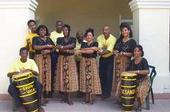Cuba's "Haitianos"?
Between 1795 and 1805 30,000 Haitians emigrated to eastern Cuba. Two more waves followed, 1920-1940 and the 1980's.
Today, estimates of the Haitian population in Cuba range from 300,000 to 1 million. Each wave of emigrants had its own distinct characteristics and brought with them their strong music and dance traditions, religion and cultural habits on their journey from Haiti to Cuba.
Grupo Vocal Desandann is an extraordinary Cuban vocal group of Haitian descent. The ensemble is composed mainly of second and third generation Haitians who were born and raised in Cuba, particularly in Camaguey. They preserve the rich cultural patrimony of their parents' and grandparents' birthplace through music. These artists execute with brilliance the most beautiful folkloric and popular songs of Haiti's yesteryears: the Haiti when Lumane Casimir, Haiti's most celebrated diva in the 1940s, was singing about the beauty of her country and who charmed the tourists with her sensational and magnificent voice. It was the Haiti when love was king.
Grupo Vocal Desandann, with it's unique Creole expression, is a revelation to its listeners. This Haitiano-Cuban musical group possesses a rich and varied repertoire. The nostalgic force of their music has caused some to shed tears. Listening to songs such as Gued» Nib¤, Haiti Ch»rie and Choucoune can give anyone Goosebumps. When they sing Lawouze or FÀy, which features a gay and explosive rustic rhythm called rab--day, even the most timid people will jump to their feet.
The warm and rousing interpretations of Grupo Vocal Desandann's songs bring jubilation and warmth in everyone's heart. We must add that Grupo Vocal Desandann has enhanced the true value and beauty of Haitian music through radio, television and festivals in Cuba and the U.S. Their superb performance in October of 1997 in New York City was a vivid testimony to that exceptional quality they master.
